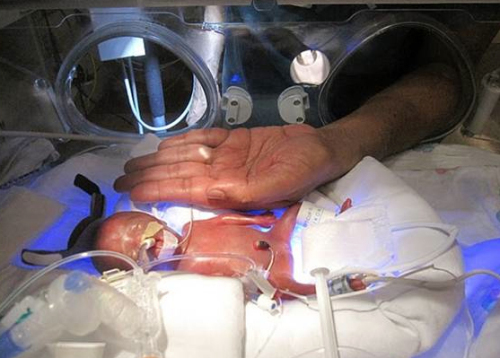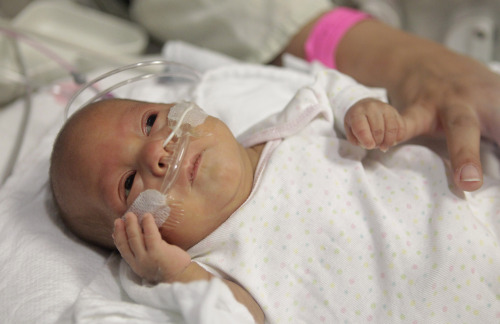LOS ANGELES (AP) _ At birth, Melinda Star Guido was so tiny she could fit into the palm of her doctor's hand. Weighing just 9 1/2 ounces (.26 kilograms), she is among the smallest babies ever born in the world. Most infants her size don't survive, but doctors are preparing to send her home by New Year's.


Melinda was born premature at 24 weeks over the summer and spent the early months cocooned in an incubator in a neonatal intensive care unit in California. Almost every day, her 22-year-old mother sits at her bedside and stays overnight whenever she can.
The day before her Thursday due date, Haydee Ibarra visited Los Angeles County-USC Medical Center where her daughter has been since her birth in August.
Melinda is believed to be the second smallest baby to survive in the U.S. and third in the world.
Ibarra caressed Melinda through the portholes of the incubator where nurses pinned up a homemade sign bearing her name. Now weighing four pounds (1.8 kilograms), Melinda gripped Ibarra's pinky finger and yawned.
``Melinda, Melinda,'' she cooed at her daughter dressed in a polka dot onesie. ``You're awake today.''
During her pregnancy, Ibarra suffered from high blood pressure, which can be dangerous for both mother and fetus. She was transferred from a hospital near her home to the county's flagship hospital, which was better equipped to handle high-risk pregnancies.
There was a problem with the placenta, the organ that nourishes the developing fetus. The fetus, however, was not getting proper nutrition, blood and oxygen. Doctors knew Melinda would weigh less than a pound, but they were surprised at how small and fragile she was.
``The first few weeks, it was touch and go. None of us thought the baby was going to make it,'' said Dr. Rangasamy Ramanathan, who oversees premature infants.
Even if she survived, doctors told Ibarra and her husband Yovani Guido, children born this extremely premature can have developmental delays and impairments such as blindness, deafness or cerebral palsy.
Ibarra, who previously had a stillborn, told doctors to do whatever necessary to help her baby.
``They said, `We'll take the chance. Please try.' So we said. `OK we'll try,''' Ramanathan recalled.
Melinda was delivered by cesarean section at 24 weeks and was immediately transferred to the NICU where a team of doctors and nurses kept watch around the clock. Infants born before 37 weeks are considered premature.
Melinda was kept insulated in an incubator and was hooked up to a machine to aid her breathing. She got nutrition through a feeding tube. Her mother said her skin felt like plastic because it was so thin.
``It takes a lot of good care and a lot of good luck. Most of them don't survive,'' said pediatrician Dr. Edward Bell of the University of Iowa who keeps an online database of the world's smallest surviving babies who were less than a pound at birth.
The list currently contains 126 babies dating back to 1936. Since submission is voluntary, it does not represent all survivors.
Ten babies weighing less than a pound were born last year and survived. Melinda joins three other tiny survivors delivered this year in Berkeley; Seoul, South Korea; and Iowa City, Iowa. All are bigger than Melinda, who is not eligible to be listed until she gets discharged.
Prematurity comes with high costs. Ramanathan estimates it costs $3,000 to $5,000 a day to care for a premature infant.
Most tiny babies who survive tend to be female. That's because female fetuses mature faster than males of the same gestational age. Having more developed lungs and other vital organs increases odds of survival.
Bell published a study last year that found many survivors struggle with health and learning problems. For those for whom growth data are available, many are short and underweight for their age.
There are some success stories.
The smallest surviving baby born weighing 9.2 ounces is now a healthy 7-year-old and another who weighed 9.9 ounces at birth is an honors college student studying psychology. Their progress was detailed in a study published this week in the journal Pediatrics by doctors at Loyola University Medical Center in Illinois where the girls were born.
In the past three years, Los Angeles County-USC Medical Center treated two other babies with extremely low birth weight who survived, but Melinda holds the record at the hospital.
A month after she was born, she was treated for an eye disorder that's common in premature babies. She faced her biggest test last month when she underwent surgery to close an artery that usually seals after birth.
Ybarra held Melinda for the first time after the surgery. Before that, she could only touch her through the incubator. The next challenge is learning to bottle feed before discharge. Ramanathan predicted at least another two-week stay, dashing her parents' hopes of taking her home by Christmas.
Ramanathan said it's too early to know how Melinda will fare when she grows up. Since she did not have major complications such as bleeding in the brain, he held out hope.
Melinda can breathe by herself, but still uses an oxygen tube as a precaution. On Wednesday, an ophthalmologist checked out her eyes and said everything looked good.
After the checkup, Ibarra lifted Melinda out of the incubator and sat in a rocking chair, cradling her.
<한글 기사>
세계 세번째 저체중 6개월 미숙아 퇴원 임박
열달을 못 채우고 6개월 만에 태어난 미숙아가 의료진의 보살핌을 받아 영양 주입 튜브를 떼고 젖병을 스스로 빨 수 있는 과제에도 전한다. 성공하면 퇴원이다.
로스앤젤레스의 남가주대 의료센터에서 지난 8월부터 인큐베이터에서 보살핌을 받는 멜린다 스타 귀도는 태어날 때 몸무게가 269g으로 미숙아 최소 체중으로 미국 내 2위, 세계 3위를 기록했다. 의사의 손바닥에 몸이 딱 맞을 정도로 크기가 작았다 .
엄마인 하이디 이바라(22)는 고혈압 탓에 태반이 약해져 태아에게 영양과 산소를 충분히 공급해줄 수 없는 처지였다. 의사들은 태아가 1파운드(453g)가 채 안 될 것이라고 짐작했지만, 막상 제왕절개 수술을 해보니 너무 작아 놀랐고 한다.
이 병원의 미숙아 담당 의사인 랑가사미 라마나탄은 15일(현지시간) "생후 초기 몇 주간은 아기가 겨우겨우 버텨 애가 해낼 것이라고 아무도 믿질 않았다"라고 말했다.
또 미숙아가 살아나더라도 성장이 늦고 시력이나 청력 장애, 뇌성마비 등을 겪을 수 있다고 부모에게 미리 경고했다고 한다.
멜린다는 출산 후 즉시 중환자실 인큐베이터에 들어가 24시간 의료진의 보호를 받았다. 외부 감염을 막은 채 기계 장치로 호흡하며 튜브 통해 영양을 섭취하며 조금씩 자랐다.
세계 최소 체중의 미숙아를 돌봤던 소아과 전문의인 아이오와대 에드워드 벨 박 사도 온라인을 통해 자료를 살피며 멜린다 살리기에 동참했다.
올해 몸무게가 1파운드 미만의 미숙아 중 생존한 경우는 캘리포니아 버클리, 한 국의 서울, 아이오와주 아이오와 시 등 3곳에서 보고됐으나 이 통계는 자발적으로 제출하는 것이라 모든 생존 미숙아를 포함하지 않는다. 멜린다도 퇴원해야 통계에 오를 자격을 얻는다.
엄마 뱃속에서는 여아가 남아보다 폐 같은 주요 장기의 성장이 빨라 같은 미숙아로 태어나더라도 생존할 확률이 높다.
대개 성장이 늦지만, 최소 체중(260g) 미숙아는 이제 건강한 7살 소녀로, 280g으로 태어난 미숙아는 대학에서 심리학을 배우는 우등 여대생으로 성장한 구체적 사 례가 이번 주 소아과 저널에 발표됐다.
멜린다는 생후 1달이 지나 받은 안과 검진에서 이상이 없는 것으로 나타났고, 보통 아기들이 생후 자연스럽게 막히는 동맥 폐쇄 수술도 받았다. 수술 후 처음으로 엄마 품에 안겼다.
하지만 목표로 잡은 새해 전까지 퇴원하려면 젖병 무는 법을 배워야 한다.
담당의 라마나탄은 속단할 수 없다고 말하면서도 뇌출혈 같은 심각한 합병증이 없었던 만큼 잘 커갈 수 있다는 희망을 이어갈 수 있다고 내다봤다.
세계 세번째 저체중 6개월 미숙아 퇴원 임박
열달을 못 채우고 6개월 만에 태어난 미숙아가 의료진의 보살핌을 받아 영양 주입 튜브를 떼고 젖병을 스스로 빨 수 있는 과제에도 전한다. 성공하면 퇴원이다.
로스앤젤레스의 남가주대 의료센터에서 지난 8월부터 인큐베이터에서 보살핌을 받는 멜린다 스타 귀도는 태어날 때 몸무게가 269g으로 미숙아 최소 체중으로 미국 내 2위, 세계 3위를 기록했다. 의사의 손바닥에 몸이 딱 맞을 정도로 크기가 작았다 .
엄마인 하이디 이바라(22)는 고혈압 탓에 태반이 약해져 태아에게 영양과 산소를 충분히 공급해줄 수 없는 처지였다. 의사들은 태아가 1파운드(453g)가 채 안 될 것이라고 짐작했지만, 막상 제왕절개 수술을 해보니 너무 작아 놀랐고 한다.
이 병원의 미숙아 담당 의사인 랑가사미 라마나탄은 15일(현지시간) "생후 초기 몇 주간은 아기가 겨우겨우 버텨 애가 해낼 것이라고 아무도 믿질 않았다"라고 말했다.
또 미숙아가 살아나더라도 성장이 늦고 시력이나 청력 장애, 뇌성마비 등을 겪을 수 있다고 부모에게 미리 경고했다고 한다.
멜린다는 출산 후 즉시 중환자실 인큐베이터에 들어가 24시간 의료진의 보호를 받았다. 외부 감염을 막은 채 기계 장치로 호흡하며 튜브 통해 영양을 섭취하며 조금씩 자랐다.
세계 최소 체중의 미숙아를 돌봤던 소아과 전문의인 아이오와대 에드워드 벨 박 사도 온라인을 통해 자료를 살피며 멜린다 살리기에 동참했다.
올해 몸무게가 1파운드 미만의 미숙아 중 생존한 경우는 캘리포니아 버클리, 한 국의 서울, 아이오와주 아이오와 시 등 3곳에서 보고됐으나 이 통계는 자발적으로 제출하는 것이라 모든 생존 미숙아를 포함하지 않는다. 멜린다도 퇴원해야 통계에 오를 자격을 얻는다.
엄마 뱃속에서는 여아가 남아보다 폐 같은 주요 장기의 성장이 빨라 같은 미숙아로 태어나더라도 생존할 확률이 높다.
대개 성장이 늦지만, 최소 체중(260g) 미숙아는 이제 건강한 7살 소녀로, 280g으로 태어난 미숙아는 대학에서 심리학을 배우는 우등 여대생으로 성장한 구체적 사 례가 이번 주 소아과 저널에 발표됐다.
멜린다는 생후 1달이 지나 받은 안과 검진에서 이상이 없는 것으로 나타났고, 보통 아기들이 생후 자연스럽게 막히는 동맥 폐쇄 수술도 받았다. 수술 후 처음으로 엄마 품에 안겼다.
하지만 목표로 잡은 새해 전까지 퇴원하려면 젖병 무는 법을 배워야 한다.
담당의 라마나탄은 속단할 수 없다고 말하면서도 뇌출혈 같은 심각한 합병증이 없었던 만큼 잘 커갈 수 있다는 희망을 이어갈 수 있다고 내다봤다.








![[KH Explains] Hyundai-backed Motional’s struggles deepen as Tesla eyes August robotaxi debut](http://res.heraldm.com/phpwas/restmb_idxmake.php?idx=644&simg=/content/image/2024/05/16/20240516050605_0.jpg&u=20240516155018)









